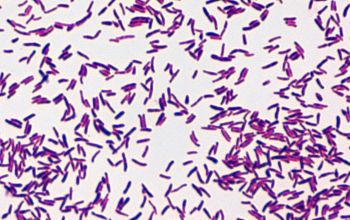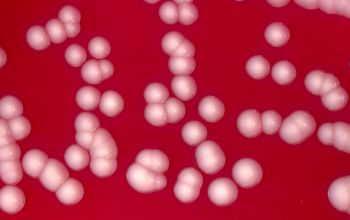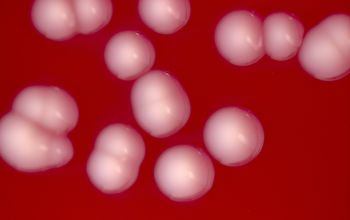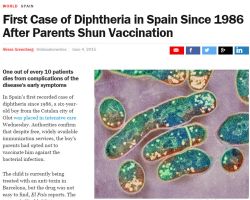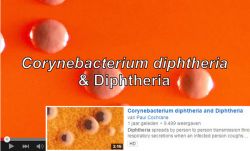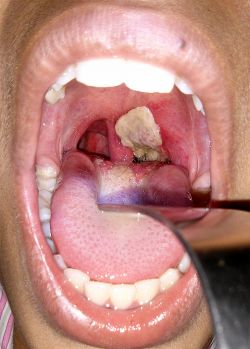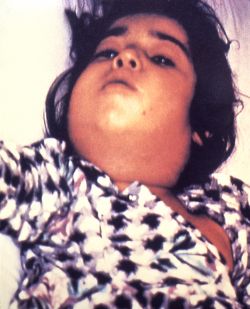First Case of Diphtheria in Spain Since 1986
After parents shun vaccination
A six-year old boy died
june 2015
Author Alissa Greenberg
TIME
http://time.com/3908566/spain-diphtheria-infection-disease-disease-vaccination-infection-anti-vaxxer/
methylene blue from a Pai's slant culture
Source CDC
https://commons.wikimedia.org/wiki/File:Corynebacterium_diphtheriae_Gram_stain.jpg
Dirty white pseudomembrane classically seen in diphtheria
Author Dileepunnikri
wikimedia commons
https://commons.wikimedia.org/wiki/File:Dirty_white_pseudomembrane_classically_seen_in_diphtheria_2013-07-06_11-07.jpg
This child with diphtheria presented with a characteristic swollen neck, sometimes referred to as “bull neck”. Diphtheria is an acute bacterial disease involving primarily the tonsils, pharynx, larynx, nose, skin, and at times other mucous membranes. The mucosal lesion is marked by a patch or patches of an adherent grayish membrane with a surrounding inflammation.
Source CDC
https://commons.wikimedia.org/wiki/File:Diphtheria_bull_neck.5325_lores.jpg
A diphtheria skin lesion on the leg. Corynebacterium diphtheriae can not only affect the respiratory system, but the skin as well, where it manifests as an open wound.
Source CDC
https://commons.wikimedia.org/wiki/File:A_diphtheria_skin_lesion_on_the_leg._PHIL_1941_lores.jpg
Corynebacterium diphtheriae
-
General information
Diphtheriae is an acute, toxin-mediated disease caused by the bacterium C. diphtheria.
The name of the disease is derived from the Greek diphtheria, meaning ”leather hide”, because of the leathery layer that grows on the tonsils, throat, and nasal passage.
Taxonomy
Family: Corynebacteriaceae
- C. diphtheria biotype gravis
- C. diphtheria biotype mitis
- C. diphtheria biotype intermedius (lipophyl)
- C. diphtheria biotype belfanti
Natural habitats
Human carriers are the reservoir for C. diphteriae and are usually asymptomatic.
C. diphtheria can be isolated from the nasopharynx as well as from skin lesions, which actually represent a reservoir for the spread of diphtheria.
Transmission
Transmission is most often person-to-person contact or contact with items that have the bacteria on them, such as an infected person’s cup or used tissue.
Rarely, transmission may occur from skin lesions.
Clinical significance
C. diphtheria infects the nasopharynx or skin.
Toxigenic strains secrete a potent exotoxin which cause diphtheria.
Toxin production (toxigenicity) occurs only when the bacteria itself infected (lysogenized) by a specific virus (bacteriophage) carrying the genetic information for the toxin (tox gene). Only toxigenic strains can cause severe disease.
The symptoms of diphtheria include pharyngitis, fever, swelling of the neck or area surrounding the skin lesion.
Diphtheritic lesions are covered by an adherent pseudomembrane. (characteristic)
The toxin is distributed to distant organs by the circulatory system and may paralysis and congestive heart failure.
C. diphtheria may also cause cutaneous diphtheria.
Some people with poor hygienic standards (e.g., drugs or alcohol abusers) are prone to colonization on the skin, (more often than in the pharynx ) by C. diphtheria strains, which are often nontoxigenic.
Diphtheria spread easily, but can be prevented through the use of vaccines.
If left untreated, diphtheria can cause severe damage to kidneys, nervous system, heart and can be fatal.
-
Diseases
-
Gram stain
Gram positive rods,
irregularly shaped (‘coryneforms”), with club-shaped swelled ends, and they are arranged as single cells, in pairs, in V forms, in palisades, or in clusters with
a so-called Chinese-letter appearance.
They color irregular, especially if they are stained with methylene blue.
This is due to the intracellular presence of metachromatic granules, especially after growth on a Loeffler medium.
-
Culture characteristics
-
Facultative anaerobic
biotype gravis
BA: large (2-3mm), opaque, rough, "matt"appearance, no hemolysis (or faint)
biotype mitis
BA: Medium (1-2mm), smooth, moist, convex, often beta-hemolytic .
biotype intermedius
BA: Small (0.5-1mm) gray, smooth (lipophyl) and some times small zone of β-hemolysis
biotype belfanti
Is equal to the biotype mitis,
McConkey: no growth
BBAØ: growth
Tellurite (selective media)
They produce small to medium black colonies.
-
-
Characteristics
-
References
James Versalovic et al.(2011) Manual of Clinical Microbiology 10th Edition
Karen C. Carrol et al (2019) Manual of Clinical Microbiology, 12th Edition
Clinical Microbiology of Coryneform Bacteria Guido Funke Clin Microbiol Reviews, jan 1997
Centers for Disease Control and Prevention Diphtheria Epidemiology and Prevention of Vaccine-Preventable Diseases


